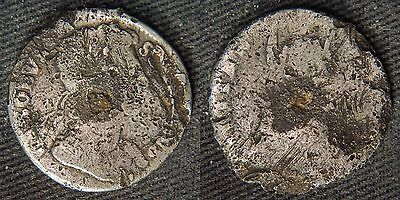Options
Added a wee bit more olde British Tin to the collection, James II Farthing
In an effort to learn and understand the American Plantations Token the related Tin coinage of the monarchs of this period becomes relavent. With the "anti counterfeiting" measure of a square copper plug they qualify as a bimetallic coin. Fairly thick it has a lettered edge which was applied on a table with a device that ran the edge of the coin under spring pressure against an iron die. Irregularities in this usually distorted rims. Incredibly soft these coins "wore" in a way best described as "smooshing". Features soften and widen, as you may expect from a piece struck in such soft metal. Tin, on the Mohs mineral hardness scale is 1.5. Talc is 1. Lead is 1.5. Silver/Gold 2.5 and copper 3. So in Any purse of the era, the Tin Farthing was really beat up. The River Thames, the mud of its banks...create an Anerobic environment which substantially aids these fragile coins in avoiding "tin pest". This piece was such a recovery. It may have been lost prior to 1700.... While it may look frumpy dumpy it's got some unquestioned rarity and is indeed a "Survivor" in every sense. Enjoy! 



0
Comments
Purportedly it was an ill advised effort to help out the struggling Cornish tin mines - the coinage was so shortlived that I doubt it was consequential to Cornwall. As noted, even in deplorable shape - the tin coins are seldom found as identifiable objects now. In fact I have never seen one in the wilds myself.
RMR: 'Wer, wenn ich schriee, hörte mich denn aus der Engel Ordnungen?'
CJ: 'No one!' [Ain't no angels in the coin biz]
World Collection
British Collection
German States Collection
The most common one is the 1685 with a star on either side of the date and a star between NVMMORVM and FAMVLVS shown as NVMMORVM * FAMVLVS * 1685 *, and Peck lists it as Rare, with the others all being Very Rare to Exceedingly Rare. Note the star shape is fairly sharp and with 5 points. Other varieties may have a dot (period) substituted for the stars, or missing a star in any of the locations, or a fat star (for want of a better term) located between FAMVLVS and 1685.
World Collection
British Collection
German States Collection